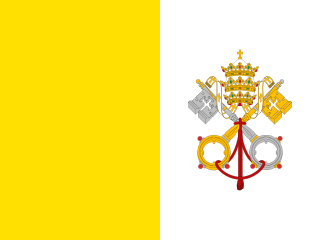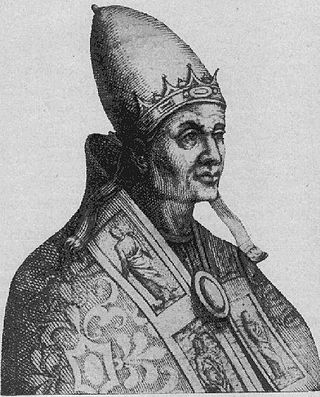
Antipope Boniface VII, otherwise known as Franco Ferrucci, was a Catholic prelate who claimed the Holy See in 974 and from 984 until 985. A popular tumult compelled him to flee to Constantinople in 974; he carried off a vast treasure, and returned in 984 and removed Pope John XIV (983–984) from office. He is supposed to have put Pope Benedict VI to death. After a brief second rule, he died under suspicious circumstances. He is today considered an antipope.

Pope Sergius I was the bishop of Rome from 15 December 687 to his death, and is revered as a saint by the Roman Catholic Church. He was elected at a time when two rivals, Paschal and Theodore, were locked in a dispute about which of them should become pope. His papacy was dominated by his response to the Quinisext Council, the canons of which he steadfastly refused to accept. Thereupon Emperor Justinian II ordered Sergius' arrest, but the Roman people and the Italian militia of the exarch of Ravenna refused to allow the exarch to bring Sergius to Constantinople.
Pope Lando was the bishop of Rome and the ruler of the Papal States from around September 913 to his death around March 914. His short pontificate fell during an obscure period in papal and Roman history, the so-called Saeculum obscurum (904–964).

The Papal States, officially the State of the Church, were a conglomeration of territories in the Italian Peninsula under the direct sovereign rule of the pope from 756 until 1870. They were among the major states of Italy from the 8th century until the unification of Italy, between 1859 and 1870.

The Holy See exercised political and secular influence, as distinguished from its spiritual and pastoral activity, while the pope ruled the Papal States in central Italy.

Saeculum obscurum, also known as the Pornocracy or the Rule of the Harlots, was a period in the history of the papacy during the first two thirds of the 10th century, following the chaos after the death of Pope Formosus in 896 which saw seven or eight papal elections in as many years. It began with the installation of Pope Sergius III in 904 and lasted for 60 years until the death of Pope John XII in 964. During this period, the popes were influenced strongly by a powerful and allegedly corrupt aristocratic family, the Theophylacti, and their relatives and allies. The era is seen as one of the lowest points of the history of the papal office.
The papal household or pontifical household, called until 1968 the Papal Court, consists of dignitaries who assist the pope in carrying out particular ceremonies of either a religious or a civil character.

According to Roman Catholicism, the history of the papacy, the office held by the pope as head of the Catholic Church, spans from the time of Peter to the present day.
Palatinus, Latin for "palatial", were designations for various ecclesiastical offices in the Catholic Church, primarily of certain high officials in the papal court.
The Apostolic Camera, formerly known as the Papal Treasury, was an office in the Roman Curia. It was the central board of finance in the papal administrative system and at one time was of great importance in the government of the States of the Church and in the administration of justice, led by the Camerlengo of the Holy Roman Church, originally known as camerarius (chamberlain).
Protovestiarios was a high Byzantine court position, originally reserved for eunuchs. In the late Byzantine period, it denoted the Empire's senior-most financial official, and was also adopted by the medieval Serbian state as protovestiyar (прото-вестијар).
The history of the Roman Curia, the administrative apparatus responsible for managing the affairs of the Holy See and the Catholic Church, can be traced to the 11th century when informal methods of administration began to take on a more organized structure and eventually a bureaucratic form. The Curia has undergone a series of renewals and reforms, including a major overhaul following the loss of the Papal States, which fundamentally altered the range and nature of the Curia's responsibilities, removing many of an entirely secular nature.
The vestiarion, sometimes with the adjectives basilikon ("imperial") or mega ("great"), was one of the major fiscal departments of the Byzantine bureaucracy. In English, it is often known as the department of the Public Wardrobe. Originating from the late Roman palace office of the sacrum vestiarium, it became an independent department in the 7th century under a chartoularios. By the late Byzantine period, it had become the state's sole treasury department. The public vestiarion must not be confused with the Byzantine emperor's private wardrobe, the oikeiakon vestiarion, which was headed by the prōtovestiarios.

Papal income tax was first levied in 1199 by Pope Innocent III, originally requiring all Catholic clergy to pay one-fortieth of their ecclesiastical income annually in support of the Crusades. The second income tax was not levied until the Fourth Lateran Council in 1215, and constituted only a triennial twentieth.

The Byzantine Papacy was a period of Byzantine domination of the Roman Papacy from 537 to 752, when popes required the approval of the Byzantine Emperor for episcopal consecration, and many popes were chosen from the apocrisiarii or the inhabitants of Byzantine-ruled Greece, Syria, or Sicily. Justinian I reconquered the Italian peninsula in the Gothic War (535–554) and appointed the next three popes, a practice that would be continued by his successors and later be delegated to the Exarchate of Ravenna.
The praepositus sacri cubiculi was one of the senior palace offices in the Late Roman Empire. Its holder was usually a eunuch, and acted as the grand chamberlain of the palace, wielding considerable authority and influence. In the 7th or 8th century, the title was also given to an order of rank for eunuch palace servants. The title and office continued in use in the simplified form of praipositos (πραιπόσιτος) in the Byzantine Empire until the late 11th century.

The Tusculan Papacy was a period of papal history from 1012 to 1048 where three successive relatives of the counts of Tusculum were installed as pope.

The Placidia Palace was the official residence of the papal apocrisiarius, the ambassador from the pope to the patriarch of Constantinople, and the intermittent home of the pope himself when in residence at Constantinople. The apocrisiarius held "considerable influence as a conduit for both public and covert communications" between pope and Byzantine emperor.
The apocrisiarius or apocrisiary was the legate from the pope to the patriarch of Constantinople, circa 452–743, equivalent to the modern nunciature.

The papal nobility are the aristocracy of the Holy See, composed of persons holding titles bestowed by the Pope. From the Middle Ages into the nineteenth century, the papacy held direct temporal power in the Papal States, and many titles of papal nobility were derived from fiefs with territorial privileges attached. During this time, the Pope also bestowed ancient civic titles such as patrician. Today, the Pope still exercises authority to grant titles with territorial designations, although these are purely nominal and the privileges enjoyed by the holders pertain to styles of address and heraldry. Additionally, the Pope grants personal and familial titles that carry no territorial designation. Their titles being merely honorific, the modern papal nobility includes descendants of ancient Roman families as well as notable Catholics from many countries. All pontifical noble titles are within the personal gift of the pontiff, and are not recorded in the Official Acts of the Holy See.











